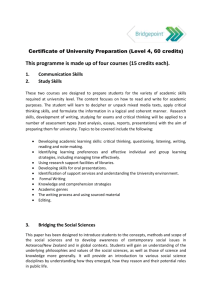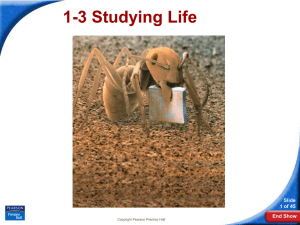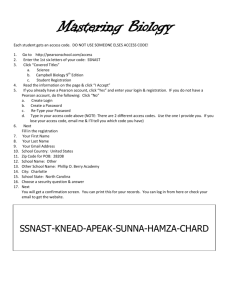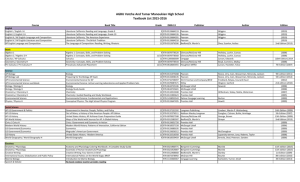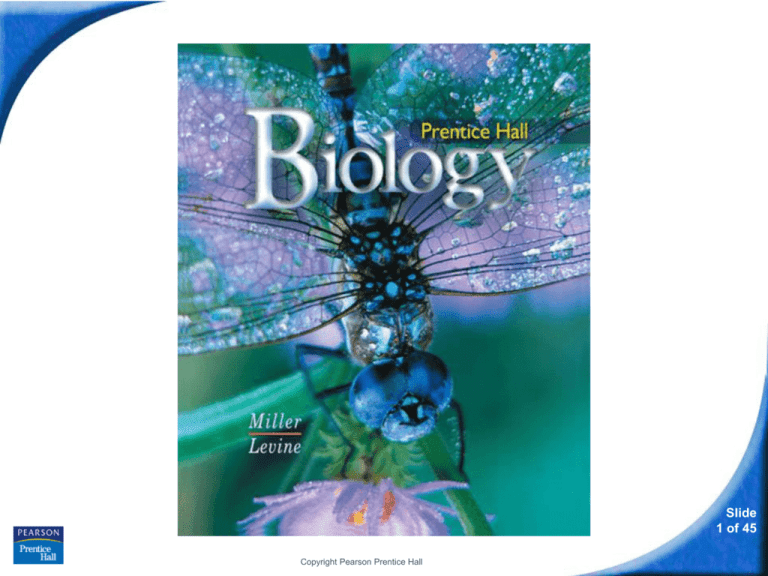
Biology
Slide
1 of 45
Copyright Pearson Prentice Hall
1-3 Studying Life
Slide
2 of 45
Copyright Pearson Prentice Hall
1-3 Studying Life
Characteristics of Living Things
Characteristics of Living Things
Organism = living thing
Organisms share certain characteristics. (We’ll
discuss 8.)
Some nonliving things may also have some of
those traits.
Slide
3 of 45
Copyright Pearson Prentice Hall
1-3 Studying Life
Characteristics of Living Things
Living things share the following
characteristics:
• made up of units called cells
• reproduce
• based on a universal genetic code
• grow and develop
• obtain and use materials and energy
• respond to their environment
• maintain a stable internal environment
• change over time
Slide
4 of 45
Copyright Pearson Prentice Hall
1-3 Studying Life
Characteristics of Living Things
Living things are:
1. made up of cells.
A cell is the smallest unit of an organism that can be
considered alive.
Slide
5 of 45
Copyright Pearson Prentice Hall
1-3 Studying Life
Characteristics of Living Things
2. reproduce.
In sexual reproduction, cells from two different
parents unite to form the first cell of the new
organism.
In asexual reproduction, a single parent produces
offspring that are identical to itself.
Slide
6 of 45
Copyright Pearson Prentice Hall
1-3 Studying Life
Characteristics of Living Things
3. grow and develop.
During an organism’s development, cells
differentiate, which means that the cells look
different from one another and perform different
functions.
Slide
7 of 45
Copyright Pearson Prentice Hall
1-3 Studying Life
Characteristics of Living Things
4. based on a universal genetic code.
Organisms store the information they need to live,
grow, and reproduce in a genetic code in a molecule
called DNA.
Slide
8 of 45
Copyright Pearson Prentice Hall
1-3 Studying Life
Characteristics of Living Things
5. obtain materials and use energy.
The combination of chemical reactions through
which an organism builds up or breaks down
materials is called metabolism.
Slide
9 of 45
Copyright Pearson Prentice Hall
1-3 Studying Life
Characteristics of Living Things
6. respond to their environment.
A stimulus (stimuli) is a change in the environment
to which an organism responds.
Slide
10 of 45
Copyright Pearson Prentice Hall
1-3 Studying Life
Characteristics of Living Things
7. maintain a stable internal environment.
Although conditions outside an organism may
change, conditions inside an organism tend to
remain constant.
This process is called homeostasis.
Slide
11 of 45
Copyright Pearson Prentice Hall
1-3 Studying Life
Characteristics of Living Things
8. Taken as a group, livings things change over time.
Over many generations, groups of organisms
typically evolve.
Slide
12 of 45
Copyright Pearson Prentice Hall
1-3 Studying Life
Big Ideas in Biology
Big Ideas in Biology
Science as a Way of Knowing
Science is not just a list of “facts.”
The job of science is to use observations,
questions, and experiments to explain the natural
world.
Slide
13 of 45
Copyright Pearson Prentice Hall
1-3 Studying Life
Big Ideas in Biology
Interdependence in Nature
All forms of life on Earth are connected together
into a biosphere, which literally means “living
planet.”
The relationship between organisms and their
environment depends on both the flow of energy
and the cycling of matter.
Slide
14 of 45
Copyright Pearson Prentice Hall
1-3 Studying Life
Big Ideas in Biology
Matter and Energy
Life’s most basic requirements are matter that
serves as nutrients to build body structure and
energy to fuel the processes of life.
Slide
15 of 45
Copyright Pearson Prentice Hall
1-3 Studying Life
Big Ideas in Biology
Cellular Basis of Life
Organisms are composed of one or more cells,
which are the smallest units that can be
considered fully alive.
Slide
16 of 45
Copyright Pearson Prentice Hall
1-3 Studying Life
Big Ideas in Biology
Information and Heredity
Life’s processes are directed by information carried
in a genetic code that is common, with minor
variations, to every organism on Earth.
That information, carried in DNA, is copied and
passed from parents to offspring.
Slide
17 of 45
Copyright Pearson Prentice Hall
1-3 Studying Life
Big Ideas in Biology
Unity and Diversity of Life
All living things are fundamentally alike at the
molecular level, even though life takes an almost
unbelievable variety of forms.
Slide
18 of 45
Copyright Pearson Prentice Hall
1-3 Studying Life
Big Ideas in Biology
Evolution
In biology, evolution, or the change in living things
through time, explains inherited similarities as well
as the diversity of life.
Slide
19 of 45
Copyright Pearson Prentice Hall
1-3 Studying Life
Big Ideas in Biology
Structure and Function
Structures evolve in ways that make particular
functions possible, allowing organisms to adapt to
a wide range of environments.
Slide
20 of 45
Copyright Pearson Prentice Hall
1-3 Studying Life
Big Ideas in Biology
Homeostasis
An organism’s ability to maintain a relatively stable
internal environment in the face of changing
external conditions is vital to its survival.
Slide
21 of 45
Copyright Pearson Prentice Hall
1-3 Studying Life
Big Ideas in Biology
Science, Technology, and Society
Science seeks to provide useful information, but
only a public that truly understands science and
how it works can determine how that information
should be applied.
Slide
22 of 45
Copyright Pearson Prentice Hall
1-3 Studying Life
Branches of Biology
Branches of Biology
There are many branches of biology. For example:
• Zoologists study animals.
• Botanists study plants.
• Paleontologists study ancient life.
Slide
23 of 45
Copyright Pearson Prentice Hall
1-3 Studying Life
Branches of Biology
How can life be studied at different levels?
Slide
24 of 45
Copyright Pearson Prentice Hall
1-3 Studying Life
Branches of Biology
Some of the levels at which life can be
studied include:
• molecules
• cells
• organisms
• populations of a single kind of organism
• communities of different organisms in an
area
• the biosphere
Slide
25 of 45
Copyright Pearson Prentice Hall
1-3 Studying Life
Branches of Biology
Biosphere
The part of Earth that contains all ecosystems
Slide
26 of 45
Copyright Pearson Prentice Hall
1-3 Studying Life
Branches of Biology
Ecosystem
Community and its nonliving surroundings
Hawk, snake, bison, prairie dog, grass, stream, rocks, air
Slide
27 of 45
Copyright Pearson Prentice Hall
1-3 Studying Life
Branches of Biology
Community
Populations that live together in a defined area
Hawk, snake, bison, prairie dog, grass
Slide
28 of 45
Copyright Pearson Prentice Hall
1-3 Studying Life
Branches of Biology
Population
Group of organisms of one type that live in the same
area
Bison herd
Slide
29 of 45
Copyright Pearson Prentice Hall
1-3 Studying Life
Branches of Biology
Organism
Individual living thing
Bison
Copyright Pearson Prentice Hall
Slide
30 of 45
1-3 Studying Life
Branches of Biology
Groups of Cells
Tissues, organs, and organ systems
Nervous tissue
Brain
Nervous system
Slide
31 of 45
Copyright Pearson Prentice Hall
1-3 Studying Life
Branches of Biology
Cells
Smallest functional unit of life
Nerve cell
Slide
32 of 45
Copyright Pearson Prentice Hall
1-3 Studying Life
Branches of Biology
Molecules
Groups of atoms; smallest unit of most chemical
compounds
Water
DNA
Slide
33 of 45
Copyright Pearson Prentice Hall
1-3 Studying Life
Branches of Biology
At all these levels, smaller living systems are found
within larger systems.
Slide
34 of 45
Copyright Pearson Prentice Hall
1-3 Studying Life
Biology in Everyday Life
Biology in Everyday Life
More than any other area of study, biology touches
your life every day.
Slide
35 of 45
Copyright Pearson Prentice Hall
1-3 Studying Life
Biology in Everyday Life
Biology provides information about the food you need
and the methods for sustaining the world’s food
supplies.
Biology describes the conditions of good health and
the behaviors and diseases that can harm you.
Slide
36 of 45
Copyright Pearson Prentice Hall
1-3 Studying Life
Biology in Everyday Life
Biology is used to diagnose and treat medical
problems.
Biology identifies environmental factors that might
threaten you.
Slide
37 of 45
Copyright Pearson Prentice Hall
1-3 Studying Life
Biology in Everyday Life
Biology helps you understand what affects the quality
of your life.
Biology provides decision makers with useful
information and analytical skills needed to predict and
affect the future of the planet.
Slide
38 of 45
Copyright Pearson Prentice Hall
1-3
Click to Launch:
Continue to:
- or -
Slide
39 of 45
Copyright Pearson Prentice Hall
1-3
An increase in size is known as
a. growth.
b. metabolism.
c. development.
d. differentiation.
Slide
40 of 45
Copyright Pearson Prentice Hall
1-3
Which of the following is NOT a characteristic of
all living things?
a. use of energy
b. made of cells
c. stable internal environment
d. need for oxygen
Slide
41 of 45
Copyright Pearson Prentice Hall
1-3
Which of the following are branches in the study
of biology?
a. cells, tissues, organs, and organisms
b. botany, cell biology, ecology, and zoology
c. populations, communities, and ecosystems
d. the genetic code, evolution, and the
biosphere
Slide
42 of 45
Copyright Pearson Prentice Hall
1-3
The genetic code is carried in
a. water.
b. DNA.
c. proteins.
d. soil.
Slide
43 of 45
Copyright Pearson Prentice Hall
1-3
Which of the following shows the levels of
organization in correct order from the simplest to
the most complex?
a. organisms, cells, populations, molecules,
ecosystems
b. ecosystems, populations, organisms, cells,
molecules
c. molecules, cells, organisms, populations,
ecosystems
d. molecules, organisms, cells, populations,
ecosystems
Copyright Pearson Prentice Hall
Slide
44 of 45
END OF SECTION


